Food has always been a gateway to understanding and appreciating different cultures. It takes us on a culinary journey where we seek to discover the rich tapestry of flavors and traditions that different cultures offer.
One such cuisine that has been given new life in recent years is Indigenous, specifically Native American. Chefs and caterers across North America are entering into the culinary spotlight to share their stories. Their decolonized approach to cooking lets heritage dishes and ingredients shine, educating diners on what American food means and where it came from. The approach may be new, but the cuisine is very, very old.

Buffalo salad with wild blueberries from Chef Crystal Wahpepah (a member of the Kickapoo Nation). Photo courtesy Wahpepah’s Kitchen via Facebook
However, it is not just about tantalizing taste buds, but also about celebrating the cultural richness and heritage of Indigenous communities.
“[Food] is so integral to our identity as Cherokee people and native people,” said Chef Nico Albert Williams (a member of the Cherokee nation) with Burning Cedar Indigenous Foods (Tulsa) in an article. “Our foods teach us lessons about who we are, and they connect us to our ancestors through the ingredients that we use, and they connect us to the land. Our ancestors lived so closely tied with the land, and then over the course of colonization, we’ve kind of been removed from that land.”
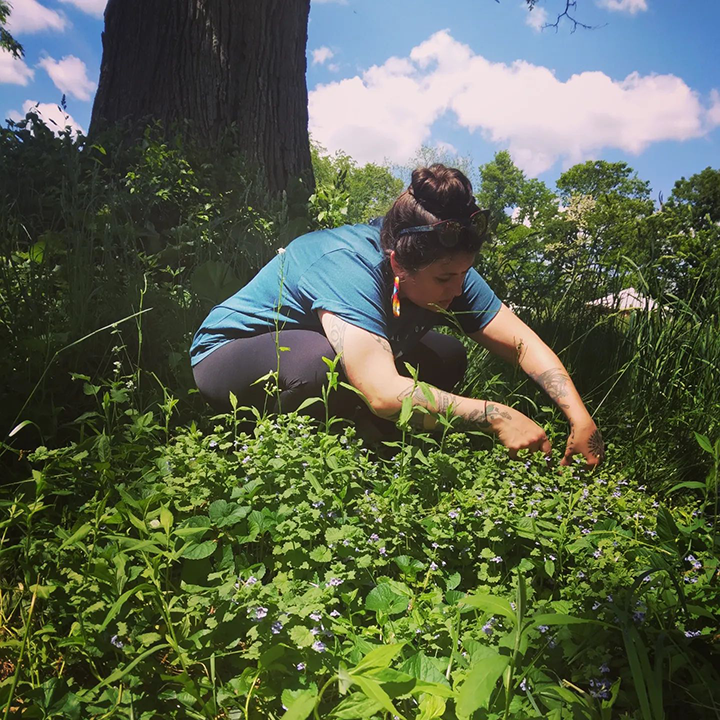
Cherokee Nation citizen and Chef Nico Albert Williams forages for wild edibles. Williams shares her knowledge of Indigenous foods to educate and teach people how to reconnect to their heritage through food. Photo courtesy Burning Cedar Indigenous Foods via Facebook
As we explore the current world of Indigenous cuisine, we must first look at its past to understand its present and its future.
A loss of tradition
Throughout history, Native Americans have passed down information—including food traditions—from one generation to the next through stories, histories, legends, and myths. Elders would teach younger generations how to prepare wild game and fish, how to find wild plants, which plants are edible, their names, their uses for food and medicine, and how to grow, prepare, and store them.
However, as European settlers spread throughout America and displaced Native American tribes onto reservations, Indigenous food customs were upended and completely disrupted, and in some cases completely lost.
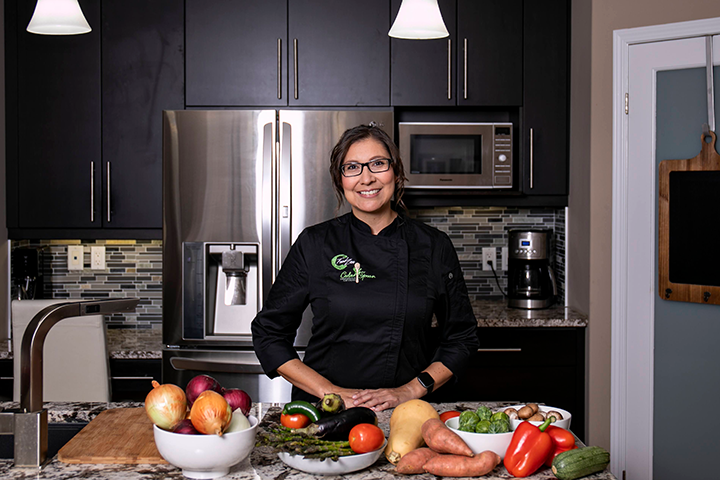
Chef Destiny Moser, owner of FoodZen and founder of Cedar Spoon Indigenous Catering. Photo courtesy Sylvia Pond Photography
"For many years I couldn’t celebrate my culture or the foods of Canada because I didn’t know what they were,” says Chef Destiny Moser (who is Anishinaabe, part of the Ojibway tribe of Rainy River) with Cedar Spoon Indigenous Catering (Kitchener, Ontario). “Growing up I didn’t hear the traditional stories behind the Indigenous food, nor was I passed down their recipes."
Beyond Native American Cuisine
While Native American may be the most widely known, Indigenous cuisine encompasses traditions and flavors of Indigenous cultures around the world. Each dish is carefully crafted to honor the ancestral knowledge and techniques that have shaped Indigenous cuisines. From the Indigenous communities of North and South America to the Aboriginal and Torres Strait Islander peoples of Australia, the Māori of New Zealand, and the Inuit of the Arctic, Indigenous cuisine embraces a wide range of culinary practices.
Māori
The Māori have been cooking with ingredients from New Zealand’s native forests for more than a thousand years. Examples of Māori food include:
- Plants: kūmara, yam, taro, puha, Māori potato (taewa tutaekuri), watercress, seaweed, asparagus fronds, kawakawa, horopito, native ferns, vines, palms, fungi, kamokamo, berries, fruit, manuka (Ti tree), and seeds
- Proteins: Kiore (the Polynesian rat) and Kurī (the Polynesian dog)
- Birds: mutton birds and moa
- Seafood: abalone, oysters, crayfish, green-lipped mussels, kina (sea urchin), and paua (sea snails)
- Grains: Rēwena paraoa (potato bread) tastes sweet and has a slight sour or tangy flavor to it, a result of the long period of fermentation it undergoes.
Information courtesy www.newzealand.com
Latin America
Within Latin America, there are several Indigenous peoples including the Huichol (also known as the Wixárika), the Aztecs, the Mayans, and the Purhépecha. Examples of Indigenous foods include:
- Plants: maize (corn), wild plums, guava, berries, chilies, plantains, squash, tomatoes, prickly pear cacti, and chocolate
- Roots: cassava
- Herbs: cilantro
- Legumes: beans
- Proteins: iguana eggs, poultry, pork, grasshoppers, and deer
- Grains: rice, quinoa, and tortillas
- Dishes: tamales, churipu, and mole
Information courtesy XYU and Beyond
Caribbean
Originally the culture of the Caribbean was comprised of the Indigenous Arawaks, Caribs, Taino, and Ciboney. These Indigenous peoples were mostly hunters and gatherers, but they did cultivate some crops as well.
Examples of their Indigenous foods include:
- Roots: cassava
- Tubers: sweet potato
- Legumes: peanuts, beans
- Plants: corn, peppers, chilies, squash, and pineapples
- Jerk: Originally a style of cooking meat that originated with the Taino people
- Bush teas: derived from native ingredients such as Ginger Thomas (trumpet flower bush), soursop (a fruit that tastes like apple and strawberries and has a custardlike inner flesh), Wormgrassk, and inflammation bush
- Pepperpot Stew: this spicy concoction is of Taino origin full of vegetables, chilies, and meat thickened with boiled cassava
- Ouicou: a fermented cassava beer developed by the Carib people
- Taumali: a Carib sauce made from the green livers of lobsters with hot chilies and lime added
Information courtesy XYU and Beyond
Polynesian/Native Hawaiian
The Waianae Diet in Hawaii is based on the traditional Hawaiian diet, which is high in complex carbohydrates and fiber and low in fat.
Traditional foods include:
- Proteins: pipi kaula (salt-rubbed, dried beef delicacy), Lomi salmon (a fresh tomato, onion, and salmon salad), beef stew, squid luau, and kālua pork
- Roots: poi (taro)
- Tubers: sweet potatoes and yams
- Plants: breadfruit, greens, seaweed, and fruit,
- Dessert: haupia (coconut milk and yam)
Information courtesy National Library of Medicine
Aboriginal/Native Australian
Australian bush food, colloquially and affectionately called “bush tucker,” refers to any food or ingredient native to the lands of Australia, be it flora or fauna. Much of Australia’s native bush foods were traditionally used by the Indigenous inhabitants as a source of nourishment during the huntergatherer days before the arrival of the colonial settler. These foods include:
- Proteins: kangaroo, emu, crocodile, and witchetty grubs
- Plants: desert quandong (desert peach), desert lime, finger lime, ruby saltbush, lemon myrtle, and Tasmanian Pepperberry
- Nuts and Seeds: bunya nut, Moreton Bay chestnut, and bush coconut
Information courtesy Tour Hero
Inuit
The Inuit nations primarily come from Alaska, Canada, and Greenland and historically consisted of foods found in Greenlandic cuisine, Yup’ik, and Aleut cuisines, often referred to as country food. This style of cuisine traditionally included game meats, migratory birds, fish, and foraged foods.
Traditional foods include:
- Proteins: walrus, seal, whale, reindeer (caribou), polar bear, muskox, migratory birds (duck and goose), sculpin, Arctic cod, Arctic char, capelin, and lake trout
- Plants: berries (crowberry and cloudberry) and herbaceous plants (grasses and fireweed)
- Tubers and stems: mousefood and roots of various tundra plants
- Roots: tuberous spring beauty and sweet vetch
- Seaweed
Information courtesy the Canadien Encyclopedia
Sámi
The Sámi people are the Indigenous people of the northern part of the Scandinavian Peninsula and large parts of the Kola Peninsula and live in Sweden, Norway, Finland, and Russia.
Traditional foods include:
- Proteins: reindeer, salmon, common whitefish, perch, roach, Arctic char, moose, and sheep
- Plants: cloudberry and lingonberry
- Fungi: mushrooms
- Herbs: garden angelica
- Tubers: almond potatoes
- Breads: Gahkko or tunnbröd (thin bread)
Information courtesy Backpack Adventures
Peru
Within the Amazon region of Peru dwells several Indigenous groups (51 in total) including Achuar, Aguaruna, Asháninka, Shipibo, Huambisa, Quechua, and Aymara, who together comprise about 45% of the population. Peru’s rainforestto-table movement is based on foods long eaten by Indigenous people in Peru’s largest region, and this cuisine is as full of flavor as it is of health benefits.
Traditional foods include:
- Fruits: acai berries, aguaje, camu camu, cocona, cupuaco, passion fruit, and bananas/plantains
- Nuts and seeds: Sacha Inchi seeds
- Juane: a mixture of rice, meat (such as chicken or guinea pig), hard-boiled eggs, olives, herbs, and spices, wrapped in bijao leaves, and boiled in clay pots
- Tacacho balls: sliced plantain that’s been fried and then mashed with fried pork fat (chicharones), usually served with a side of fried sausage (chorizo) or cecina, which is salted dried pork or beef which is smoked before being fried
- Inchicapi: a classic, creamy Amazonian soup of chicken, crunchy chunks of hearts of palm or manioc, flavored with peanuts, coriander leaves and stems (cilantro), and coriander seeds
- Jungle spaghetti: shredded new shoots from the heart of the palm, harvested from the top of the tree
- Manioc (also known as yucca or cassava): a starchy root vegetable that’s a staple for Amazonian communities—an ingredient in many soups, stews, and other traditional dishes, also thickly sliced and fried, and roasted as chips
- Seafood: tambaqui (also called pacu) and paiche (also known as arapaima and pirarucú)
- Patarashca: a packet of marinated fish, onions, and other vegetables seasoned with cilantro, tumeric, and other spices, wrapped in bijao leaves and grilled
Information courtesy PROMPERU
Africa
In the time before recorded history, Africa was not only the birthplace of humans but also the food basket.
Traditional foods include:
- Plants: Baobab Tree fruit, celosia, eggplants, egusi melon
- Greens: amaranth, moringa, okra
- Nuts and seeds: marama, dika nuts, shea nuts
- Legumes: locust bean, Bambara Bean, cowpea, long beans, yam bean
- Tubers: potatoes
Information courtesy XYU and Beyond
Asia
Asia and the Pacific region is home to the largest number of Indigenous peoples with more than 70% of the world’s total Indigenous population. Some of the Indigenous people of Asia are the Veddas of Sri Lanka, The Jarawa of the Andaman Islands of India, the Kalash of Pakistan, the Naga from northeastern India and northwestern Myanmar, the Lhop of Bhutan, the Bodo of Nepal and the Giraavaru of the Maldives. In Japan, the two Indigenous peoples, the Ainu and the Okinawans, live on the northernmost and southernmost islands of the country’s archipelago.
Tradditional foods include:
- Fermented foods: kimchi, kombucha, natto, miso, and Douchi (a black bean paste), and Mianchi (a white bean paste)
- Roots: taro
- Green vegetables: bok choy, bitter melon, choy, and cucumbers
- Legumes: soybeans
- Grains: rice
Information courtesy XYU and Beyond
The ingredients that arrived with the Europeans included many of the ingredients found in today’s conventional recipes—poultry, wheat, dairy, and beef. Along with the new food came a host of health problems; today, the high rates of obesity, diabetes, hypertension, and heart disease can all be traced back to the European diet.
It’s only been in recent years that Indigenous peoples are starting to reconnect with their food traditions to revitalize their cultures.
“I realized the complete absence of Indigenous foods, I could name less than a handful of Lakota recipes that were truly Lakota,” says Chef Sean Sherman (member of the Oglala Lakota tribe), James Beard winning chef and owner of Owamni by the Sioux Chef (Minneapolis). “It’s not like I could go online and order the ‘Joy of Native American Cooking.’
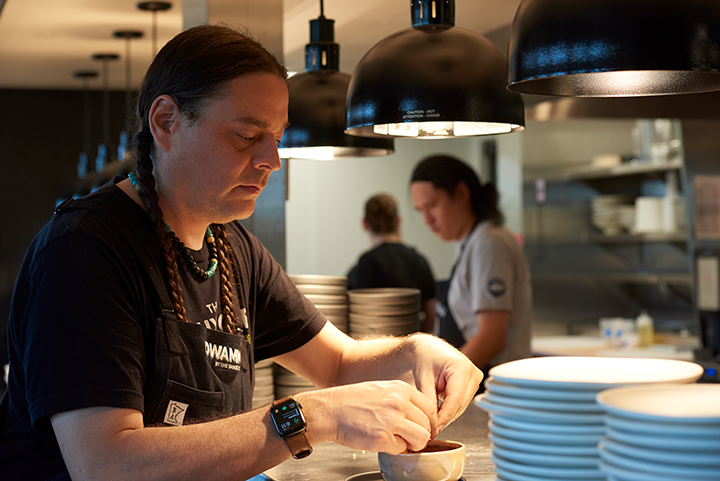
James Beard-winning Chef Sean Sherman, owner of Owamni by the Sioux Chef, is a key component of the Indigenous cuisine resurgence. He recently received the Julia Child Award and was featured in Time Magazine’s 100 Most Influential People. Photo courtesy Heidi Ehalt
“We should know about it because no matter where we are in North America, obviously all of its history begins with Indigenous history.
Reconnecting to the roots of cuisine
Sherman, Moser, and Williams are just three Indigenous chefs who are aiming to reconnect with the diet of their ancestors, who for thousands of years survived on food they found around them.
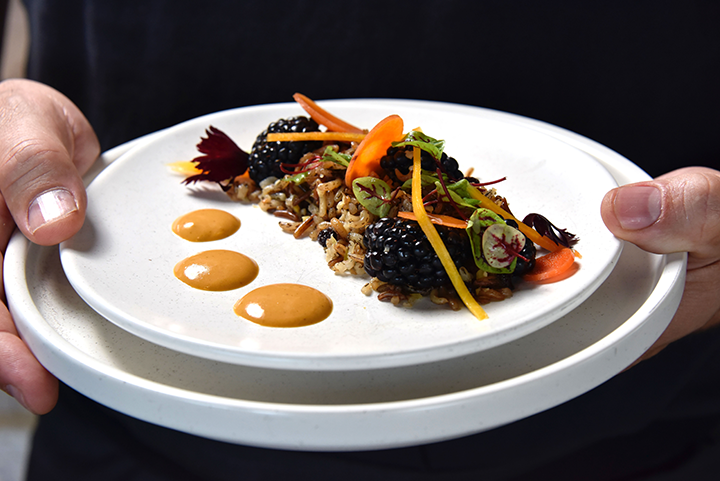
Owamni by the Sioux Chef in Minneapolis was named the Best New Restaurant during the James Beard Awards in 2022. Owner Chef Sean Sherman was named Best Chef: Midwest. Photo courtesy Nancy Bundt
“We’re trying to define what modern Indigenous food is today because we’re not trying to cook like the past. We’re trying to understand the past to apply it to now,” says Sherman. “I’m not trying to do a timepiece and cook like it’s 1491, but I want to take all that generational knowledge that we’re relearning and apply it to today to do something bigger with it. It’s become more than just serving food, it’s about talking about it and talking about why [Indigenous cuisine] isn’t here.”
A Guide to Indigenous Ingredients
Vegetables
Common vegetables included wild greens and roots such as dandelion greens, cattail roots, camas bulbs, wild onions, and turnips; and starchy vegetables such as corn and different squash varieties.
Protein
Buffalo was the predominant protein, and was used to make many dishes, including pemmican, which is dried wild meat made into a powder and mixed with melted fat and sometimes berries. Other game meat such as moose, deer, and duck were popular, along with certain types of fish. Plant-based protein sources included beans and certain types of nuts and seeds, such as sunflower seeds or pumpkin seeds.
Grains
Popular grains consisted of corn and wild rice, while wheat and wheat products were not originally part of the traditional diet. Corn was very versatile, as it could be dried, ground into a flour, and used in many dishes, including cornmeal. Wild rice, an aquatic grass, was considered an important crop and was also used in many dishes.
Fruit
Some popular fruits included berries, such as chokecherries, cranberries, saskatoon berries, blueberries, wild strawberries, and raspberries. Fruit was not only consumed fresh, but also canned, dried, or in the form of sauces.
Dairy and alternatives
Traditionally, dairy was not consumed—it was introduced later by European settlers. Calcium and Vitamin D, which are important nutrients found in dairy products, were supplied through foods such as wild greens, seeds, squash, and fish.
Information courtesy Food Insight
For Moser, her mission is to bring Indigenous ingredients back to the table, regardless of whether her recipes are traditionally “Indigenous.”
“My mission as a chef is to use the recipes I learned from my grandmothers but substitute them with Indigenous ingredients,” she says. “Food has become my path to reconciliation and a way for me to heal, show my emotions and passion. Food is holistic, it’s medicine. One of the best places to listen and learn is to break bread together and I’m excited to continue to grow and learn with our community.”
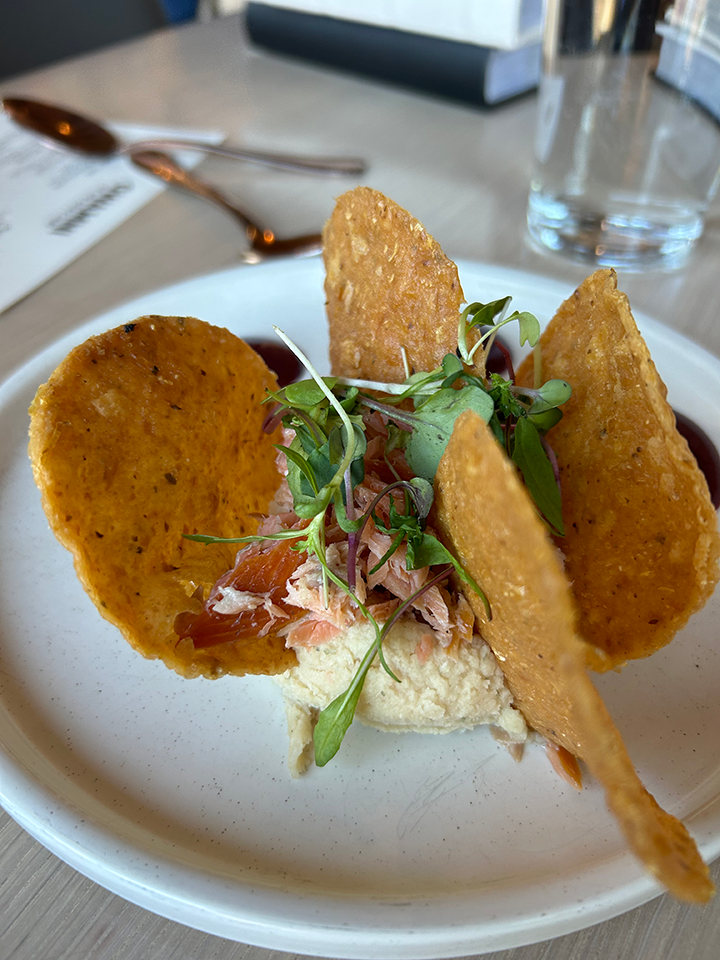
Smoked Lake Superior trout with white bean spread served with wojape and tostadas from Owamni by the Sioux Chef. Photo courtesy Catersource staff
Although Indigenous cuisine encompasses a wide range of foods and regional variations (Indigenous cultures have diverse culinary practices and food traditions), it can usually be classified as naturally high in protein, dairy-free, and gluten-free with a focus on utilizing locally sourced, seasonal ingredients and traditional cooking methods that have been passed down through generations. For example, many dishes are cooked over an open fire (click here for more on that), in a clay pot, or in a horno (a traditional Native American oven).
“The Indigenous diet is really one of the most ideal diets. It’s healthy fats, it’s diverse proteins, it’s low carbs, it’s low salt, it’s a ton of plant diversity, it’s organic agriculture, and it’s celebrating cultural and regional diversity,” says Sherman. “It’s what the paleo diet wishes it was.”
The bounty of the land
So, what classifies Indigenous ingredients? Essentially, Indigenous ingredients are any proteins, fruits, vegetables, grains, or greens that are native to an area. More specifically, these ingredients come directly from the ground or an animal, not from a supply chain. Indigenous ingredients are hyper local and ultra-seasonal.
“The western diet has really never taken the time to learn this amazing biology that’s around us and all these plants all around us,” says Sherman (click here for more information on how chefs are self-sourcing their regional ingredients). “There’s food everywhere, we should be making our pantries taste like where we are—what makes us unique in our own region. For us, with the ingredient choices we make, we are trying to make food taste like a place. We need to be better connected to our nature around us and really truly understand how it’s a symbiotic relationship.”
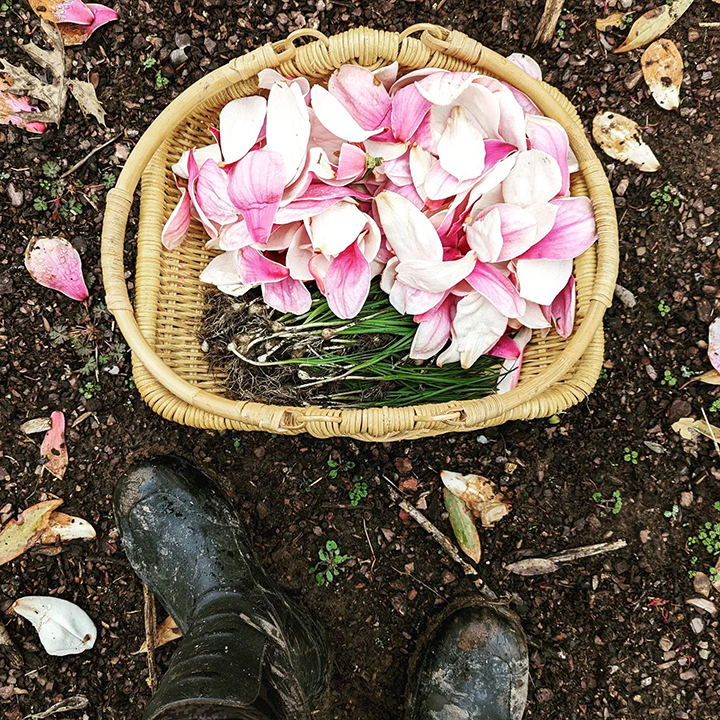
Wild onions accompanied by magnolia petals. Photo courtesy Burning Cedar Indigenous Foods via Facebook
A few examples may include bison, trout, maple syrup, and wild rice, as well as local flora such as mushrooms, beans, tips of spruce trees, wild onion, corn, squash, and berries. “There are foods that most people eat every day [that] they do not realize are Indigenous things, like carrots, squash, various nuts and berries,” said Chef Walks First, also known as Jessica Paemonekot, (a member of the Menominee tribe of Wisconsin) with Ketapanen Kitchen (Chicago) in an article.
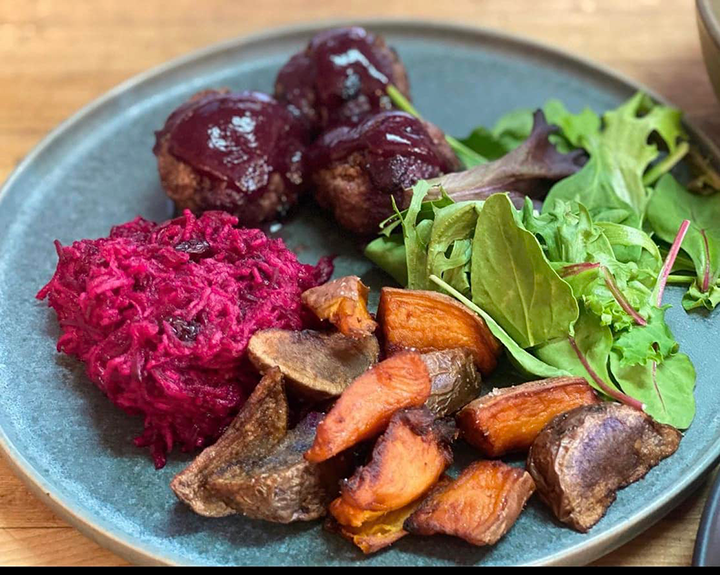
Bison blueberry meatballs with fresh harvest lettuce and turnip apple salad slaw from Chef Crystal Wahpepah (a member of the Kickapoo Nation). Photo courtesy Wahpepah’s Kitchen via Facebook
The Indigenous style of cooking also eliminates the use of colonial ingredients such as dairy, flour, cane sugar, beef, pork, and chicken, which Sherman says encourages diners to explore new ingredients outside of what they’re used to.
“You shouldn’t be afraid of something if it’s not a cow, a pig, or a chicken,” says Sherman. “There’s a lot of cool foods out there, there’s so much flavor, there’s so much to explore, there’s so much health. It’s fun for chefs to create and play with all these flavors. Chefs should be really excited about just getting to learn all these plants that aren’t in their diet.”
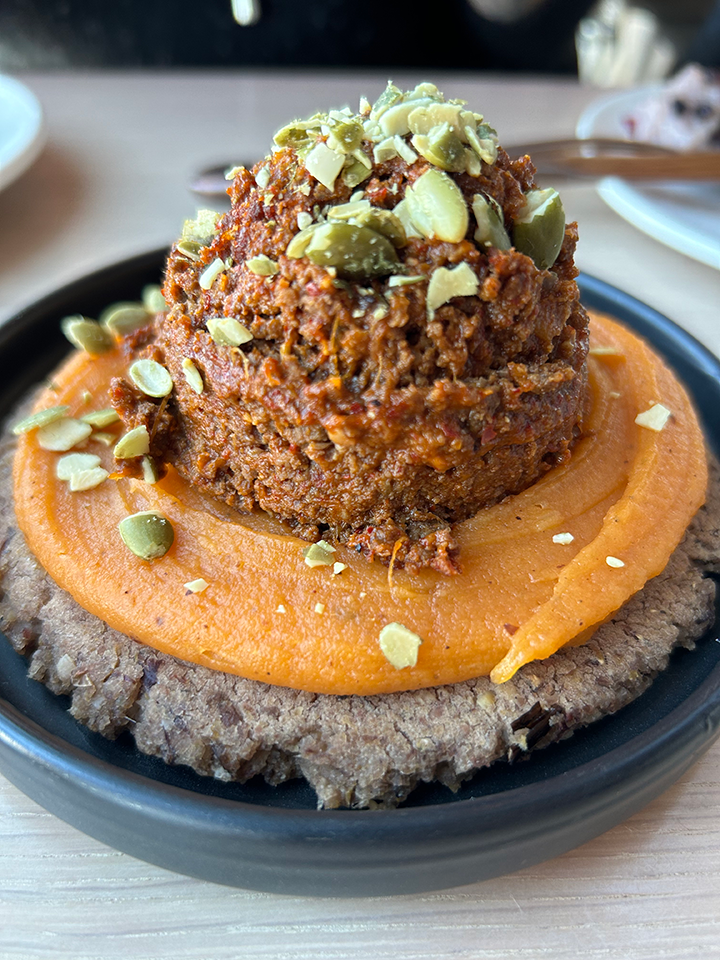
A corn sandwich featuring duck fat squash, cranberry, and sage from Owamni by the Sioux Chef. Photo courtesy Catersource staff
“I like to separate foods that were here before the settlers and after,” adds Moser.
Diversifying your menu
When incorporating Indigenous recipes and ingredients into your catering offerings (whether by client request or to diversify your menu) it’s important to approach it with open eyes and an open heart to safeguard against tokenizing and cultural appropriation.
“It’s so much about bringing to light the struggles that Indigenous peoples had and still have, and the mass inequalities that are out there. So instead of trying to put it on your menu because it’s trendy and you want to entice more clientele, it’s better to make sure that there’s a special story behind it,” says Sherman.
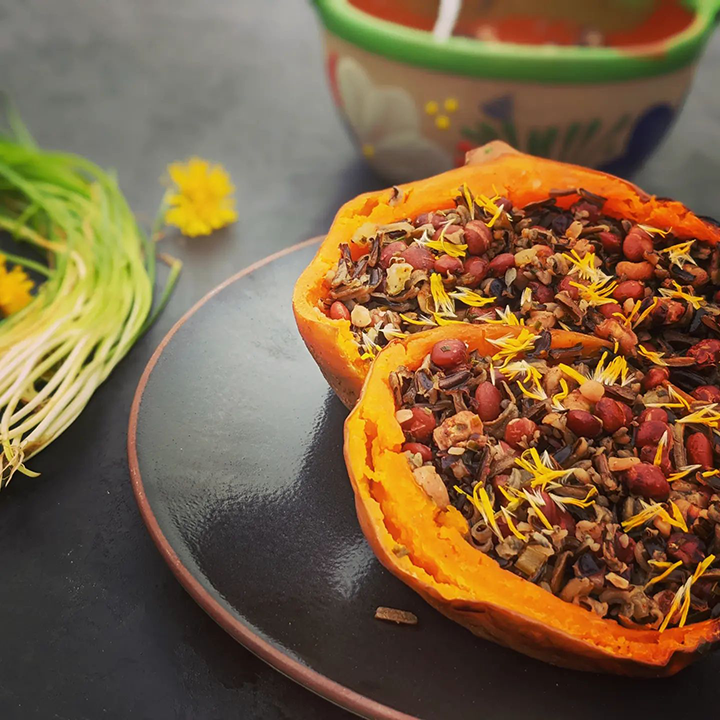
Coal-roasted Cherokee tan pumpkin stuffed with wild rice, red corn hominy, pinquito beans, wild onions and garnished with dandelion from Chef Nico Albert Williams (Cherokee Nation). Photo courtesy Burning Cedar Indigenous Foods via Facebook
To incorporate Indigenous cuisine into your menu, the first step is to immerse yourself in research and understanding. Learn about the local Indigenous cultures, their history, traditional ingredients, cooking techniques, and the significance of food in their daily lives. Consult resources such as cookbooks, documentaries, and local experts to gain a deeper appreciation for the diverse Indigenous culinary traditions.
“Don’t just request the Indigenous menu, or use the ingredients; there is so much unlearning and knowledge that needs to be shared,” says Moser.
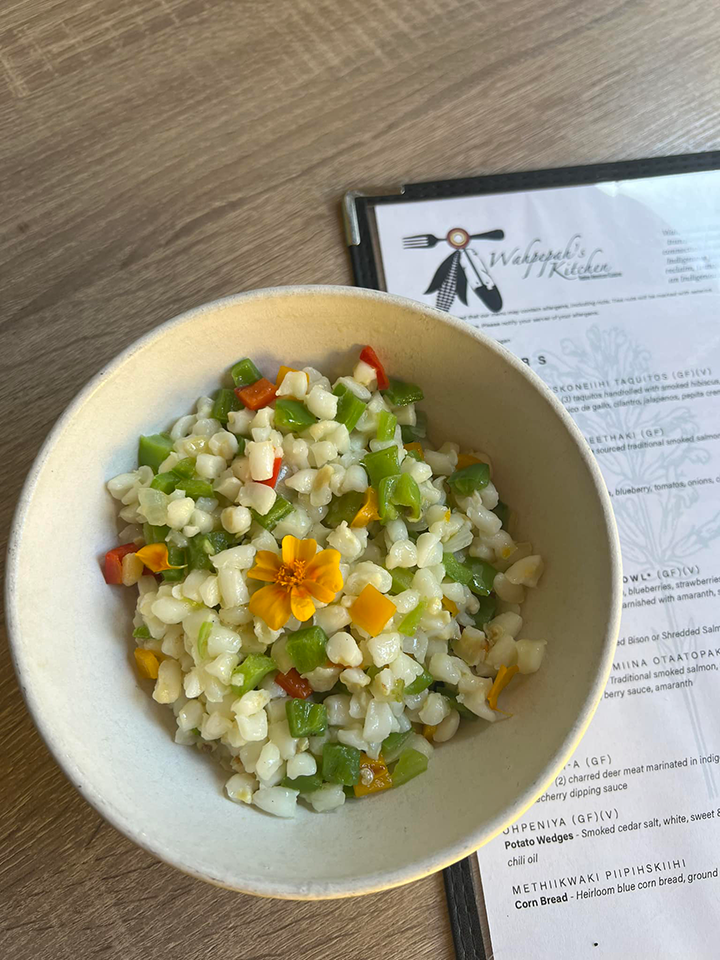
Methiikwak “Oklahoma Pearl Hominy” sautéed in duck fat with sweet peppers and onions from Chef Crystal Wahpepah (a member of the Kickapoo Nation). Photo courtesy Wahpepah’s Kitchen via Facebook
Next, approach the process with humility, acknowledging that you are a guest in their culinary world. Collaborate with Indigenous communities, chefs, and culinary experts who can guide you on cultural sensitivities, traditional recipes, and appropriate adaptations. Partnership with Indigenous farmers and producers is also paramount.
“I think the biggest thing is to really try to center some recipe creations around some Indigenous food products from Indigenous food producers,” says Sherman. “It’s about sharing that story and honoring the work that goes into it, the long legacies that these groups and tribal communities have upheld. If you’re able to do it respectfully and you’re able to really tell the story and you’re able to really highlight some of the people or partners or products that you’re utilizing and some of their stories, then it makes it more authentic.
“Claiming this food as your own and not paying respect where respect is due and putting it on your menu to make money because it looks like a good fad to jump into— then that’s a direct example of appropriation, because it’s extracting for profit, basically using somebody else’s culture.”
Also, make sure to use it as a storytelling opportunity. Indigenous cuisine is deeply intertwined with cultural narratives and histories, so incorporate storytelling into your menu, providing guests with insights into the traditions, symbolism, and significance of the dishes they are experiencing.
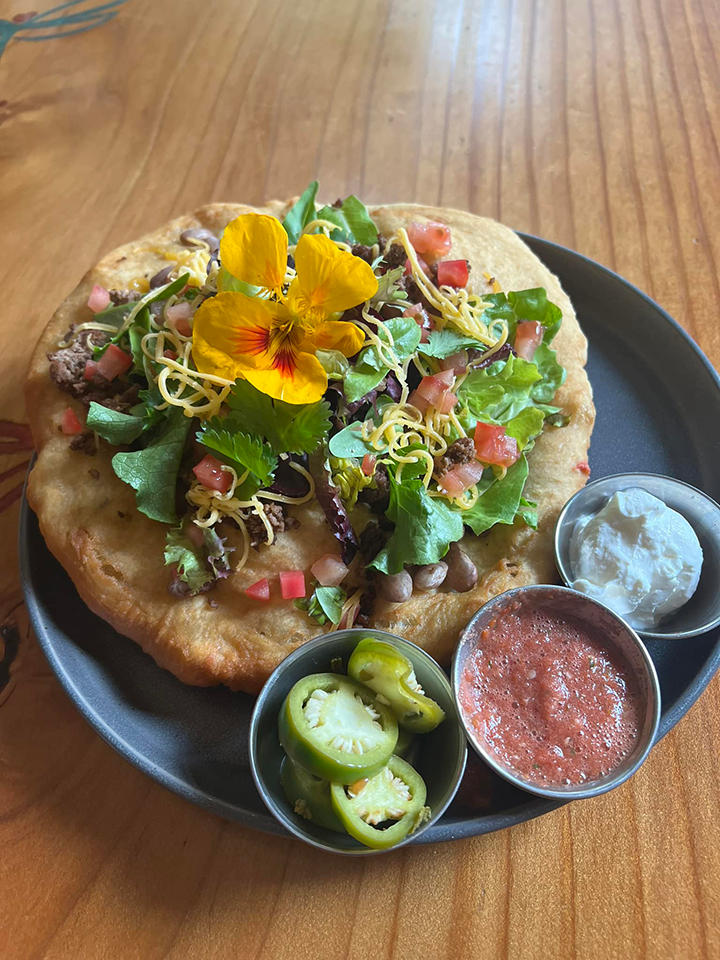
Bison Frybread Tacos from Chef Crystal Wahpepah (a member of the Kickapoo Nation). Photo courtesy Wahpepah’s Kitchen via Facebook
"I think showcasing Indigenous ingredients at any event is important, and not just serving it, but telling the story about why they may not have known it was Indigenous or why they may not have seen this on a menu before,” says Moser. “I know for me, food tastes way better when you know the story behind it.”
Lastly, don’t expect it to be the same as what you’re used to.
“Don’t expect the pricing to be the same as other catered foods you might have had; because of colonization, Indigenous ingredients have been labelled as ‘exotic’ or ‘specialty’ and that usually comes with higher prices,” says Moser, “and don’t try and use Indigenous dishes per se, but do what you know and feel comfortable with but use Indigenous ingredients.”

Sunflower seed cake with agave squash caramel from Owamni by the Sioux Chef. Photo courtesy Dana Thompson
Bringing Indigenous cuisine and cooking styles to menus is a powerful way to honor and celebrate the diverse culinary heritage of Indigenous communities. You can create a menu that reflects the depth and richness of Indigenous culinary traditions.
“It’s an exciting time to be Indigenous because we are taking all of these lessons from our ancestors that should have been passed down to us, relearning them, and utilizing them in the world today,” says Sherman. “People should celebrate the Indigenous foods and be aware of it. We should all be celebrating food no matter what because that’s something we all share.”
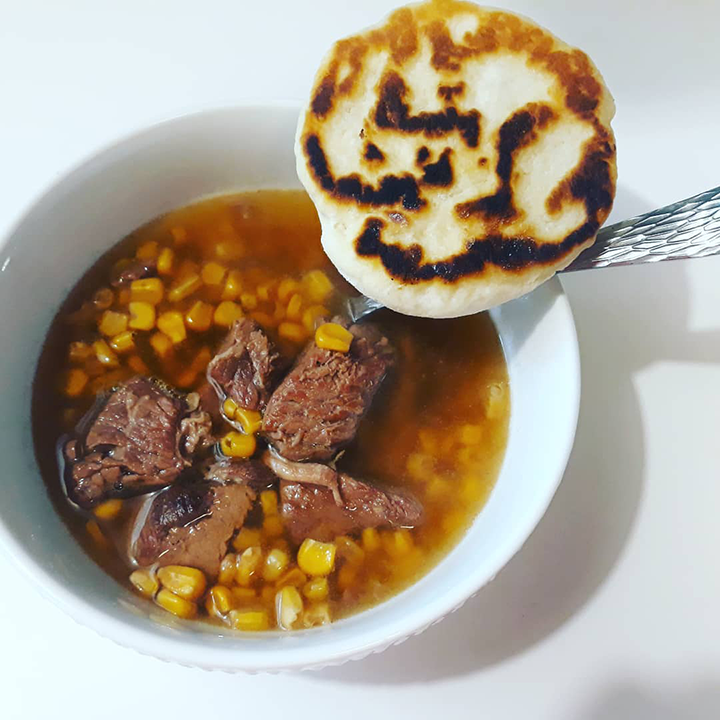
Corn soup and top bread from Chef Nico Albert Williams (Cherokee Nation). Photo courtesy Burning Cedar Indigenous Foods via Facebook



